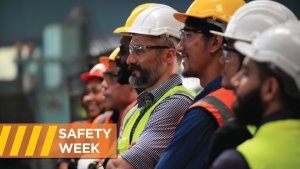Disappointed. A “head scratcher.” Puzzling.
Those are some of the terms being used by several construction industry stakeholders about the recommendations contained in a recently released report from the province’s Standing Committee on Finance and Economic Affairs called The Economic Impact of COVID-19 on Infrastructure.
The Fifth Interim Report on the Economic and Fiscal Update Act, 2020, sets out the all-party committee’s findings and recommendations following a review of how the COVID-19 crisis has affected Ontario’s infrastructure sector.
“The recommendations are a head scratcher,” said Giovanni Cautillo, president of the Ontario General Contractors Association. “After I read the report in its entirety and when I read the recommendations I went, ‘what are these recommendations, because I just read a totally different report.’ ”
Presentations were made by more than 40 stakeholders including Andy Manahan, executive director of the Residential and Civil Construction Alliance of Ontario, Cautillo, and Sandro Perruzza, chair of the board of the Construction and Design Alliance of Ontario (CDAO) and CEO of the Ontario Society of Professional Engineers.
State-of-good-repair projects needed to kickstart the economy
The report summarizes the testimony received during the public hearings held in July and August. Cautillo, Manahan and Perruzza said although their points were recognized in the report itself, they were not reflected in the recommendations.
“In the report they do touch upon what we discussed, the problem is the recommendations do not reflect all of the content in the report,” said Cautillo, who made two presentations, one on behalf of the industry and the other focusing on small and medium sized businesses.
“What we’re saying from the construction side is if you really want to kickstart the economy it’s the state-of-good-repair projects that need to be focused on right now,” added Manahan.
In his presentation, Cautillo asked the government to commit to stimulus infrastructure spending.
“If they are truly the Standing Committee on Finance and Economic Affairs, then they should really focus on what is going to impact the economy, especially in construction, in the biggest single way possible and that is getting out projects, small, medium and large,” said Cautillo. “They have to increase the amount of projects that they put out.”
Manahan said although the report covered a lot of ground, it does miss some key points.
“I mentioned something about late utility locates slowing things up if we get more stimulus funding,” said Manahan. “I was disappointed that although they wrote about it, it didn’t make it into their final 10 recommendations.”
More transparency needed with Ontario’s project pipeline
Manahan and Perruzza made comments on behalf of the CDAO, talking about more transparency with the project pipeline.
“With Infrastructure Ontario (IO) and large P3 projects we have a pretty good idea of what’s coming down the pipe, but we don’t have as good a pipeline for all the traditional projects that are done either by the province or the municipal sector,” said Manahan. “Our recommendation was to make this list like the one that IO has through their market updates. That allows the private sector and engineering firms, for example, to better prepare for the work that might be coming.”
Provincial agencies “not being reasonable” with pandemic’s impact on projects
Perruzza discussed the issue of force majeure and the fact that certain provincial agencies “are still going full force ahead with old contracts, holding the industry accountable and are not being reasonable.
“They are oblivious to the impact that COVID has had on the industry, not just on the labour side but on the supply side, the materials,” said Perruzza. “Right now, the pressure is on general contractors and engineering firms to meet contractual obligations.
“The result of that is when new contracts come up with IO and Metrolinx the contracts haven’t been adjusted to deal with the impact of COVID and firms just aren’t bidding. If the contracts and the behaviours aren’t going to recognize the impact of COVID, and now we’re in the second wave, why would we put our organization at risk to bid on this project?”
Shortage of professional engineers should be addressed: Perruzza
While the report talks about the skilled trades shortage, it does not address the shortage of professional trades like engineers, added Perruzza. He said upskilling of engineers needs to be invested in just like other trades.
“The gap they have when they leave university to being job-ready is tremendous and it takes four years,” Perruzza said. “A lot of these smaller engineering firms, because they don’t have the liquidity right now because of COVID, they can’t afford to take on an engineering student right now and train them until they are a licensed and job-ready engineer.”
Perruzza said he hopes to get clarity on whether the points raised by those in the construction industry will be addressed.
“To recognize what we said and put it in the report and then not address it in the recommendations is puzzling to us,” said Perruzza. “If they are planning to use infrastructure as one of the main levers to jump start the economy and for economic recovery and they don’t address these major issues then they’re dead in the water.”
Ontario’s Economic Impact of COVID-19 on Infrastructure report recommendations
TORONTO—The Standing Committee on Finance and Economic Affairs report, The Economic Impact of COVID-19 on Infrastructure, includes the following 10 recommendations, which have industry stakeholders who took part in the consultation process concerned for the future of Ontario’s economy.
1. The government should digitize documentation to allow electronic submissions for projects.
2. Ontario should consider reviewing its infrastructure asset portfolio to determine areas where it could leverage private sector capital by monetizing, selling or recycling assets.
3. Ontario should provide education and training to municipal leaders and staff to equip them with the skills to structure, procure and successfully deliver their infrastructure projects.
4. For smaller similar projects, the government should consider bundling smaller similar projects. The program can be built around similar types of asset or geographically.
5. Place more emphasis on the role of organizations such as Infrastructure Ontario in assisting the municipal sector deliver worthwhile projects.
6. The provincial government should work with supportive stakeholders to aggressively advocate for federal infrastructure stimulus support on provincial priorities.
7. Work with the federal government to upgrade and modernize digital infrastructure and build out broadband. These issues are significant in rural, northern and Indigenous localities.
8. Leverage Ontario’s broadband action plan funding to ensure that modern broadband connectivity is available in more public library branches in communities across Ontario, most especially rural and northern areas.
9. The province should explore ways to reduce the high costs of utility pole access that are a detriment to expanding broadband.
10. As part of the post-pandemic recovery strategy, the province should consult on the potential adoption of a utilities model used in other jurisdictions for the financing and delivery of critical water and wastewater infrastructure.
Follow the author on Twitter @DCN_Angela.








Recent Comments